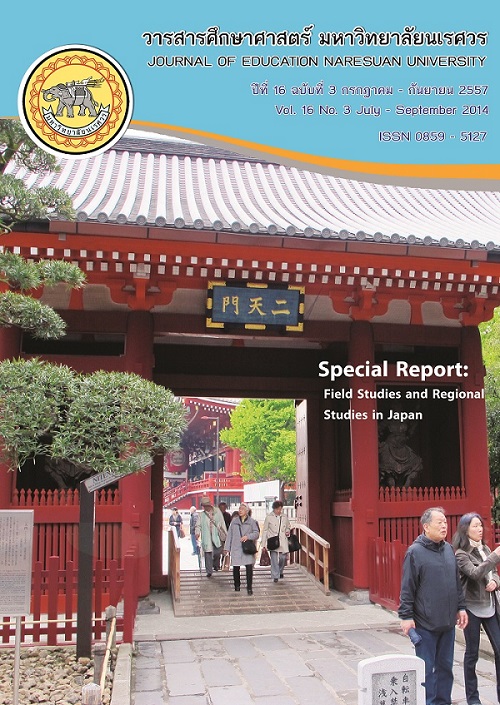การพัฒนารูปแบบการบริหารงานอาชีวศึกษาระบบทวิภาคีในสถานศึกษา สังกัดสำนักงานคณะกรรมการการอาชีวศึกษา
Main Article Content
Abstract
บทคัดย่อ
การวิจัยนี้เป็นการวิจัยและพัฒนา โดยการเก็บรวบรวมข้อมูลเชิงคุณภาพและข้อมูลเชิงปริมาณ มีวัตถุประสงค์เพื่อพัฒนารูปแบบการบริหารงานอาชีวศึกษาระบบทวิภาคีในสถานศึกษา สังกัดสำนักงานคณะกรรมการการอาชีวศึกษา โดยมีวัตถุประสงค์เฉพาะ ดังนี้ 1) เพื่อศึกษาสภาพและแนวทางในการบริหารงานอาชีวศึกษาระบบทวิภาคีในสถานศึกษา สังกัดสำนักงานคณะกรรมการการอาชีวศึกษา 2) เพื่อสร้างรูปแบบการบริหารงานอาชีวศึกษาระบบทวิภาคีในสถานศึกษา สังกัดสำนักงานคณะกรรมการการอาชีวศึกษา และ 3) เพื่อประเมินความเป็นไปได้และความมีประโยชน์ของรูปแบบการบริหารงานอาชีวศึกษาระบบทวิภาคีในสถานศึกษา สังกัดสำนักงานคณะกรรมการการอาชีวศึกษา
วิธีดำเนินการวิจัยมี 3 ขั้นตอนคือ 1) การศึกษาสภาพปัญหาและแนวทางในการบริหารงานอาชีวศึกษาระบบทวิภาคีในสถานศึกษา สังกัดสำนักงานคณะกรรมการการอาชีวศึกษา โดยการวิเคราะห์และสังเคราะห์ เอกสาร และงานวิจัยที่เกี่ยวข้อง การออกแบบเครื่องมือการวิจัย เพื่อนำไปศึกษาการบริหารงานอาชีวศึกษาระบบทวิภาคีในสถานศึกษาที่มีวิธีปฏิบัติที่ดี จำนวน 3 แห่ง โดยการสัมภาษณ์ผู้บริหารสถานศึกษา และผู้ที่เกี่ยวข้องกับอาชีวศึกษาระบบทวิภาคี และการสัมภาษณ์ผู้ทรงคุณวุฒิ จำนวน 6 คน การวิเคราะห์ข้อมูลใช้การวิเคราะห์เนื้อหา 2) การสร้างรูปแบบการบริหารงานอาชีวศึกษาระบบทวิภาคีในสถานศึกษา สังกัดสำนักงานคณะกรรมการการอาชีวศึกษา โดยนำข้อมูลจากขั้นตอนที่ 1 มายกร่างรูปแบบการบริหารงานอาชีวศึกษาระบบทวิภาคีในสถานศึกษา สังกัดสำนักงานคณะกรรมการการอาชีวศึกษา และตรวจสอบความเหมาะสมของรูปแบบฯด้วยการสนทนากลุ่มผู้ทรงคุณวุฒิ จำนวน 9 คน และ 3) การประเมินความเป็นไปได้และความเป็นประโยชน์ของรูปแบบการบริหารงานอาชีวศึกษาระบบทวิภาคีในสถานศึกษา สังกัดสำนักงานคณะกรรมการการอาชีวศึกษา โดยผู้วิจัยได้เดินทางเพื่อนำเสนอรูปแบบการบริหารงานอาชีวศึกษาระบบทวิภาคีในสถานศึกษา สังกัดสำนักงานคณะกรรมการการอาชีวศึกษา ให้กับกลุ่มผู้ให้ข้อมูลในการประเมิน สถิติที่ใช้วิเคราะห์ข้อมูลคือ ค่าเฉลี่ยและส่วนเบี่ยงเบนมาตรฐาน
ผลการวิจัยพบว่า
1. การบริหารงานอาชีวศึกษาระบบทวิภาคีในสถานศึกษา สังกัดสำนักงานคณะกรรมการการอาชีวศึกษา ประกอบด้วย 4 องค์ประกอบ ได้แก่ ปัจจัยนำเข้า กระบวนการ ผลผลิต และปัจจัยเงื่อนไขความสำเร็จ
2. รูปแบบการบริหารงานอาชีวศึกษาระบบทวิภาคีในสถานศึกษา สังกัดสำนักงานคณะกรรมการการอาชีวศึกษา ประกอบด้วย 5 องค์ประกอบที่เป็นกลไกการขับเคลื่อนให้ประสบความสำเร็จ ได้แก่ 1) คณะกรรมการบริหารงานระบบทวิภาคีในสถานศึกษา ประกอบด้วย 2 องค์ประกอบย่อย คือ 1.1) คณะกรรมการอาชีวศึกษาระบบทวิภาคี 1.2) หน้าที่ของคณะกรรมการบริหารงานอาชีวศึกษาระบบทวิภาคี 7 หน้าที่ 2) ขอบข่ายงานการบริหารงานอาชีวศึกษาระบบทวิภาคี 8 ภารกิจ 3) กระบวนการ ประกอบด้วย การวางแผน การจัดองค์กร การนำหรือการสั่งการ การลงมือปฏิบัติ การควบคุมตรวจสอบและประเมิน และการปรับปรุงและพัฒนา 4) สมรรถนะทางวิชาชีพของผู้สำเร็จการศึกษาอาชีวศึกษาระบบทวิภาคี 3 สมรรถนะ และ 5) ปัจจัยเงื่อนไขความสำเร็จในการบริหารงานอาชีวศึกษาระบบทวิภาคี
3. การประเมินรูปแบบการบริหารงานอาชีวศึกษาระบบทวิภาคีในสถานศึกษา สังกัดสำนักงานคณะกรรมการการอาชีวศึกษา ที่พัฒนาขึ้นมีความเป็นไปได้ในการนำไปปฏิบัติอยู่ในระดับมากและมีประโยชน์อยู่ในระดับมากที่สุด
คำสำคัญ: รูปแบบการบริหาร/ อาชีวศึกษาระบบทวิภาคี
Abstract
Research and development study, comprised collecting quantitative data and qualitative data. The objective of this research was to develop an administrative model for Dual Vocational Training under Vocational Education Commission with the following sub-objectives: 1) studying the states and ways of the administration of Dual Vocational training in the vocational education institutes through related documents analysis and survey of 3 purposively selected vocational education institutes with best practices, and interviewing 6 experts in vocational education institutes. Data were analyzed by content analysis. 2) drafting a tentative model for Dual Vocational Training in educational institutes based on the data obtained from step 1 and validating the model for its appropriateness through group discussion of 9 vocational education experts and 3) evaluating the validated model for its feasibility and practicality through survey research for the opinions of the Directors, Vice-Directors, Heads of Dual Vocational Training and teachers of the institutes. Data were analyzed by means and standard deviations.
The research procedure followed three steps: 1) studying the actual problems and the states and ways of the administration of Dual Vocational Training, then analyzing and synthesizing relevant document, research findings, concepts and theories, conducting multi-case studies of 3 vocational education institutes with the best practices in management, then interviewing 6 experts in Dual Vocational Training, 2) constructing of a tentative model, then checking its appropriateness through focus group discussion among 9 experts in Dual Vocational Training and 3) evaluating the feasibilities and usefulness of the model of Dual Vocational Training, the office of Vocational Educational Commission by presenting to the vocational education institutes. Data were analyzed by means and standard deviation.
The results of the research were as follows:
1. The administration for Dual Vocational Training in educational institutes under the Office of Vocational Commission consists of four main components: inputs, process, outputs and conditions for achievement.
2. The administrative model constructed for Dual Vocational Training in educational institutes under the Office of Vocational Commission consists of five main components as a mechanism to achievements: 1) the executive committees of Dual Vocational consists of two elements with 1.1) the executive committees of Dual Vocational Training 1.2) the seven duties of executive committees of Dual Vocational Training 2) framework with a mission work of the six missions 3) process with seven administrative principles: planning, organizing, leading/directing, doing, controlling, and acting 4) three student’s vocational competencies 5) condition for achievement contributing to the successful management of Dual Vocational Training.
3. The evaluation of the constructed model for Dual Vocational Training in educational institutes under the Office of Vocational Commission yielded the results as useful at a high level and the high feasible.
Keywords: Administrative Models/ Dual Vocational TrainingArticle Details
The owner of the article does not copy or violate any of its copyright. If any copyright infringement occurs or prosecution, in any case, the Editorial Board is not involved in all the rights to the owner of the article to be performed.


